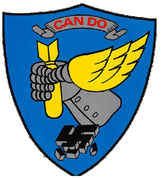This article includes a list of general references, but it lacks sufficient corresponding inline citations. (March 2017) |
| 305th Operations Group | |
|---|---|
 Group KC-10 Extender after receiving fuel from a KC-135 Stratotanker over Afghanistan | |
| Active | 1942–1946; 1947–1948; 1950–1952; 1991–1993; 1994–present |
| Country | |
| Branch | |
| Role | Airlift and Air Refueling |
| Part of | Air Mobility Command |
| Garrison/HQ | McGuire Air Force Base |
| Motto(s) | Can Do[1] |
| Engagements | European Theater of Operations[2] |
| Decorations | Distinguished Unit Citation Air Force Outstanding Unit Award[2] |
| Commanders | |
| Notable commanders | Curtis LeMay |
| Insignia | |
| 305 Operations Gp emblem[2][note 1] |  |
| 305th Bombardment Group emblem (approved 23 April 1951)[1] |  |
| 305th Bombardment Group emblem (World War II)[3] |  |
The 305th Operations Group is a United States Air Force unit assigned to the 305th Air Mobility Wing. It is stationed at the McGuire AFB entity of Joint Base McGuire-Dix-Lakehurst, New Jersey.
During World War II, the group's predecessor unit, the 305th Bombardment Group was one of the first VIII Bomber Command Boeing B-17 Flying Fortress units in England, and, was one of the most-decorated USAAF heavy-bombardment groups in the European Theater. 1st Lt William R. Lawley, Jr. and 1st Lt Edward S. Michael, pilots in the 364th Bomb Squadron, each received the Medal of Honor.
While commanded by Colonel Curtis LeMay the 305th Bomb Group pioneered many bomber flying formations and bombing procedures that became the standard operating procedures in the Eighth Air Force.
The group lost thirteen aircraft during the 14 October 1943 Schweinfurt mission, the heaviest loss of any group on the mission, and for this reason was given a Nazi flag found flying in the city as a war trophy when it was captured by U.S. troops in April 1945.
Cite error: There are <ref group=note> tags on this page, but the references will not show without a {{reflist|group=note}} template (see the help page).